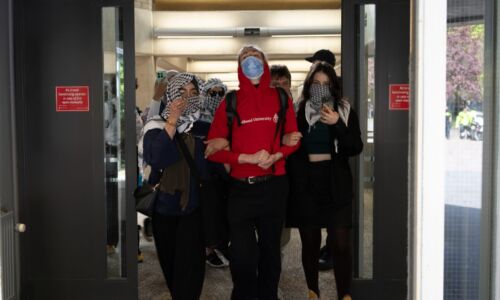How hot topic issues dominate the debate on diversity and inclusion in higher education
-
 Illustratie: Eveline Schram
Illustratie: Eveline Schram
Attempts aimed at making education more inclusive are regularly met with resistance from both advocates and opponents of diversity policy – whether it’s about shifting Western bias in the curriculum or about the signs on toilet doors. These are the four major controversies.
The debate surrounding diversity and inclusion issues in higher education is by no means a novelty – although it does seem to take on a different name in each decade. Whereas a few years ago, the debate centred mainly on performance-oriented issues, such as getting more women into senior executive positions and recruiting more international students, the issues these days are more specific and political in nature. This also means that a lot of issues are more sensitive, and people are more likely to have their feelings hurt.
Death threats
A study conducted by the independent media in 21 institutions of higher education shows that anti-racism and gender identity are the topics in relation to which tempers run the highest.
At the University of Amsterdam (UvA), for example, a number of lecturers received death threats after they called on the Executive Board to deplatform Jordan Peterson, a controversial Canadian psychologist, as a guest speaker. In an open letter, the lecturers asserted that Peterson’s transphobic and misogynist views did not align with the basic principles and values of the university, such as non-discrimination and equality. Peterson nevertheless spoke in Amsterdam and drew a full house.
In Groningen, the comments sent in to the UKrant, the independent publication of the University of Groningen, quickly derailed in response to an article with the headline ‘Groningen is just very white’, in which five people from an ethnic minority background spoke about their experiences in the city. The UKrant received 630 angry comments, including a number of furious comments containing racist or xenophobic statements, whereupon the editors decided to close the comments section.
How are educational institutions navigating this explosive landscape? Below is a summary of the major controversies.
Controversy 1: Decolonisation and inclusive teaching materials
In an opinion piece in Erasmus Magazine, the publication of the Erasmus University Rotterdam (EUR), the educationist Brian Godor referred to the decolonisation of the curriculum as ‘indoctrination’. Godor says that the goal of education and research is to learn about the world as it is, with the decolonisation of the curriculum ostensibly leading to changing the goal to ‘creating a new world’. He believes that this leads to objectivity being lost.
Nevertheless, all universities ánd the universities of applied sciences in Rotterdam and Amsterdam are devoting attention to more inclusive teaching materials and decolonising the curriculum. Several diversity officers confirm that Black Lives Matter have raised awareness on the issue of institutional racism and how the colonial past impacts our current way of thinking. This awareness has also penetrated educational institutions. Curricula are often based on European or Western perspectives and decolonisation is an attempt by programme departments at changing that state of affairs and making room for non-Western ideas and perspectives.
‘Never any question of coercion’
At Radboud University, this discussion traditionally only arises at the faculty of philosophy. To put it bluntly, students at that faculty do not want to only learn about Plato, Aristoteles, Nietzsche, and Marx, but also about non-Western thinkers. Just recently, students of the Philosophy, Politics and Society programme argued that their study programme was changing too slowly.
Still, the idea that curriculums need to be decolonised is not only reserved for Nijmegen philosophers. The DEI plan Imprinting Change of Radboud University explicitly states it as a goal.
Viewing learning materials critically through this lens is a sensitive issue. However, in response to criticism, when asked, diversity officers stated there was never any question of coercion, emphasising that the development of learning materials is initiated from the bottom up: the changes are something that lecturers themselves are increasingly demanding.
‘A DEI plan without the word decolonisation would be outdated in three years’ time’
The Nijmegen diversity officer Rona Jualla van Oudenhoven told Vox earlier that it is up to lecturers to change their curriculum. ‘It is included in the plan to draw attention to it. My role is to highlight its importance and have discussions with deans and professors.’ Van Oudenhoven received a lot of comments about stating decolonisation in the plan. I said: if we made a DEI plan without the word decolonisation, it would be outdated in three years’ time. Because I am sure every university will be talking about it by then.’
Storming of the Capitol
Diversity officers see themselves as taking up a supporting role at most, for example, by offering a toolkit for lecturers, in which academic staff can find out about ways to take look at literature critically.
Some lecturers choose to add ‘non-Western’ perspectives. Gerry Wakker is a diversity officer at the University of Groningen and is a lecturer in Classical languages and literature. She has chosen to provide context alongside any teaching materials that may be regarded as Eurocentric. ‘I discuss how we see that the classics are often the domain of elitist white men and how the extreme right sometimes appropriates this literature. For example, we discussed how classical symbols were used during the recent storming of the Capitol.’
Several diversity officers do not use the term ‘decolonise’, but rather refer to ‘making teaching materials more inclusive’. In these cases, the principal focus is on combating more forms of exclusion. Changes can sometimes be made to small details, Constance Sommerey, the diversity officer at Maastricht University explains. She cites the following example: ‘In the Property Law course, we changed the example of “Tom and Mary buy a house” to “Tom and Tim buy a house”.’
Controversy 2: Diversity is more than helping white women get a job
For many years, women were the key demographic of diversity policies at educational institutions, however, a shift is currently underway. ‘Helping white women get a job’ is how Hahae Son, a student council member at the UvA, expressed her dissatisfaction with the 2020 diversity memorandum in the independent university publication Folia.
It is now common practice not only to look at whether someone is a woman or not, but also to take into account other axes of difference, such as skin colour or socio-economic class, and how they impact one another. For example, a white woman with highly educated parents will encounter different obstacles than a woman of colour from a working-class family. In academic and activist circles, this is known as intersectional thinking. This study shows that intersectionality forms the basis of diversity policies at all the educational institutions that were studied.
A more diverse workforce
Machiel Keestra, the Chief Diversity Officer at the UvA says that ‘broadening out helps make it clear that I’m not interested in pushing through a particular agenda in an activist way.’ One of the concrete effects of this broader perspective is that diversity policies are increasingly focused more on a more diverse workforce. Universities of applied sciences in the Randstad metropolitan region, for example, are struggling with the fact that their teaching staff does not reflect their student population, which goes beyond just male-female ratios.
Diversity officer Aliya Çelik says that this is in line with what many students at the Amsterdam University of Applied Sciences want. This is an issue other universities of applied sciences within the Randstad metropolitan region are struggling with – even more so, it seems, than the universities in the same cities. Students at the universities of applied sciences are more culturally diverse than at the universities, say diversity staff at the universities of applied sciences of Rotterdam and Utrecht.
But how do you go about creating a more diverse workforce? People in management positions tend to be white and more likely to hire people who look like them, say diversity staff, and have implicit biases about people who are different.
Inclusive job ads
All the educational institutions that were studied are now tackling these unconscious biases with so-called unconscious bias training sessions to make people more aware of this. Furthermore, Radboud University and the umc did this last year with the use of interactive theatre workshops, during which employees learned to recognise their own (unconscious) biases. During the workshops, situations based on actual workplace incidents were performed.
In addition, manuals are now widely available on how to write inclusive job ads. Diversity staff are also arguing in favour of making it mandatory for job ads to expressly state that the organisation aims to foster a diverse workforce.
The fact that this has not been widely celebrated is something set out by Jules van Binsbergen in an op-ed piece in newspaper NRC that was published last September. Van Binsbergen is a Professor of Financial Economics at the University of Pennsylvania and believes that diversity statements of this type are a way of testing whether applicants are on the ‘right’ side of the political debate. He has warned that this will similarly put pressure on academic freedom in the Netherlands, as he believes is already the case in the United States.
21 institutions
The study was conducted at the following institutions: Fontys University of Applied Sciences, University of Groningen, VU University Amsterdam, Utrecht University, University of Twente, Avans University of Applied Sciences, Eindhoven University of Technology, Erasmus University Rotterdam, Rotterdam University of Applied Sciences, Radboud University Nijmegen, Utrecht University of Applied Sciences, Delft University of Technology, Arnhem Nijmegen University of Applied Sciences, Maastricht University, Amsterdam University of Applied Sciences, Hanze University of Applied Sciences, Tilburg University, Saxion University of Applied Sciences, University of Amsterdam, Wageningen University, Leiden University.
Controversy 3: Going beyond he and she
Almost all administrative systems at educational institutions are set up for the dichotomy of men and women. This no longer fits with current thinking on sex and gender. The visibility and emancipation of the transgender community is gaining momentum. In addition, there are more and more people who identify as non-binary.
There is also resistance to the change in the way we think about and approach gender identity. In a piece in the AD newspaper, for example, Pieter de Vries, a theology lecturer at the VU University Amsterdam, compared ‘gender ideology’ to Nazi ideology, making his assertions in the wake of an intense debate surrounding his support of the Nashville Statement, a Christian document that rejects homosexuality and gender transitioning, amongst other things.
Modifying registration systems
Marco Strijks, Diversity & Inclusion Liaison Officer at the Saxion University of Applied Sciences, emphasises that the demand for change does not come from the diversity office, but rather is coming from students themselves. ‘I get a lot of complaints about how gender and salutations are set up in IT systems. They don’t accommodate for non-binary people or use the wrong pronouns. You run into all sorts of bureaucratic hurdles trying to change that, and my job is to assist in that regard.’
Strijks is not the only one receiving queries about changing gender registration. The modification of registration systems is an active issue at almost all educational institutions. Recent efforts at the EUR in this regard were successful, and students can now change their pronouns in the Canvas education software.
At Radboud University, it is not possible to change your pronouns by yourself. ‘University administration uses the Basic Registration of Persons (Dutch governmental registry of personal data, ed.)’, a university spokesperson said when asked about this. ‘Students are registered the same way they are registered at the municipality. If students want something changed, they need to do that through the municipality. If their proof of identity does not include a gender, administration will follow whatever option provided by the student through Studielink.’
Another problem that diversity officers receive complaints about is the fact that the wrong, pre-transition names may be used on forms or on exam certificates. For example, at the Saxion University of Applied Sciences, a student called Quin Deen was forced to collect his HBO Propedeuse certificate with his old name on it. As long as the name a student has chosen themselves cannot be changed at an administrative level, the diversity office will find an interim solution, such as a ceremonial diploma certificate.
They/them
Language changes faster than systems do. Some people want to be addressed with pronouns other than the conventional he/him or she/her, such as with they/them. Educational institutions are trying to institutionalise the change by providing handbooks and manuals on inclusive language, which allows them to enforce rules, for example, for drafting job ads. However, face-to-face interaction, for example during lectures, is something that students and lecturers have to navigate themselves.
The fact that there is a discrepancy between how staff members and students feel about this issue is something that Constance Sommerey at Maastricht University has observed. ‘For most students, it’s a matter of course or courtesy to announce your pronouns when you meet someone. Many lecturers feel this is one step too far, and either don’t understand why it’s necessary or don’t know how to bring up the issue.’
‘For most students, it’s a matter of course or courtesy to announce your pronouns when you meet someone’
There are lecturers who prefer not to put students on the spot during a lecture. They also want to afford a degree of freedom to students who have not yet fully figured things out and do not want to force anyone to publicly speak out about their gender identity.
A number of educational institutions are therefore reticent. The Rotterdam University of Applied Sciences, for example, did not adopt a proposal put forward by the participation council to actively use gender-neutral pronouns. ‘Being social pioneers is one step too far for us at this stage’ is what the Chair of the Executive Board told the publication Profielen at the time.
Controversy 4: One toilet for all
All universities and universities of applied sciences that were studied now have at least one all-gender or gender-neutral toilet. The toilets are meant for everyone – including for people who do not identify as male or female.
In Nijmegen university buildings, inclusive bathroom facilities are now commonplace. The Erasmus building has had them for years, while only last year, around half of all bathrooms in the Huygens building were transformed into places where every human can relieve themselves. In the newest faculty building, the Maria Montessori, all bathrooms are gender neutral.
Exactly how many of these toilets should be installed is another question. Marco Strijks of Saxion University of Applied Sciences explains that it took him five years to get an all-gender toilet installed in every building. He cites an example of a member of staff who balked at the toilets near his office being renovated. ‘He thought he’d have to go further afield’, says Strijks.
Gender-neutral toilets
Once the toilets at Saxion had all been installed, people who thought they were unnecessary would scratch the stickers off the doors. There were also people who felt uncomfortable with a toilet that was accessible to all for religious reasons, alongside women who were not happy that others could enter ‘their space’. At Saxion, it was mainly the women’s toilets that were changed into all-gender toilets, which is something that Strijks would have done differently in retrospect. Ultimately, Saxion also adapted the men’s toilets.
Despite all the commotion, little has changed for people who do not want to make use of gender-neutral toilets, as all the universities and universities of applied sciences also still have separate toilets for men and women.
Justification of the methodology
This study involved an analysis of 36 policy documents from 21 educational institutions: 13 universities and 8 universities of applied sciences*. This relates to visions, strategies, memoranda, action plans and position papers in which educational institutions set out their plans.
As part of this study, we spoke to diversity officers from thirteen universities and seven universities of applied sciences about their work. Nearly all diversity officers cited having to deal with negative responses, three of which said they had received threats. As a result, a number of these individuals were reluctant to participate in this study.
* The participating media of the universities (of applied sciences) are affiliated with the Kring van Hoofdredacteuren Hoger Onderwijs Media (Circle of Editors-in-Chief of Higher Education Media).
This study was made possible in part through a contribution from the Dutch Journalism Fund.







